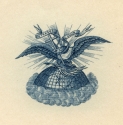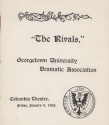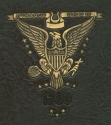Georgetown University, then Georgetown College, adopted an official seal for the first time in 1844, after the institution was incorporated by an Act of Congress. This seal borrowed many design elements from an oval emblem of the College which was created during the administration of Georgetown’s third president, William Louis DuBourg, S.S., in the late 1790s. The design of the 1844 seal was modified in the late 1880s and for the next 90 years or so it was typically rendered as round in shape and with much less detail than previously. In 1977, Father DuBourg’s original oval emblem was adopted as the official seal.
In addition to these sanctioned changes, however, administrators and students have on occasion modified the seal design according to their needs and artistic inclinations. Examples of a number of variant designs, some official, some not, are included in this exhibit.
Original College emblem
The eagle on Georgetown's seal carries two objects in its talons: a terrestrial globe, the symbol of rational knowledge, and a cross, the symbol of Christian faith. In its beak, it carries a scroll with the Latin inscription Utraque Unum which is from the Book of Ephesians and translates as “Both are one.” In the context of our seal, the phrase has been interpreted to mean that there is no necessary conflict between learning and religion. The phrase Collegium Georgiopolitanum Ad Ripas Potomaci in Marylandia ["Georgetown College on the banks of the Potomac in Maryland"] reflects the fact that the school's founding predates the incorporation of the District of Columbia in 1802 and the sixteen stars surrounding the eagle represent the number of states in the U.S. during Father DuBourg’s presidency from 1796 to 1798. The leaves on the outside of the design have been identified by some as olive (a symbol of peace) and oak (signifying strength and independence.) However, historian John Gilmary Shea in his 1891 "Memorial of the First Centenary of Georgetown College, D.C., Comprising a History of Georgetown University" identifies the leaves on the right side as laurel (signifying success and achievement), rather than olive.
Great Seal of the United States
U.S. Department of State, Bureau of Public Affairs
The design of Georgetown's seal is based closely on the Great Seal of the U.S. which was first used in 1782. The eagle on the Great Seal holds a bundle of 13 arrows, representing the 13 colonies, in one talon and an olive branch in the other. These objects together symbolize that while the country has a strong desire for peace it will always be ready to defend itself. The eagle looks towards the olive branch to indicate a preference for peace.
Award of Academic Merit in the Third Class of French, given to student John Lyne and signed by Georgetown President John Early, S.J., 1863
This version of the Georgetown seal was used between 1844 and the late 1880s.
Invitation to the Law Department Commencement, May 23, 1877
A variant on the seal shown on the 1863 Award of Academic merit, this rendering more clearly depicts a bald eagle than previous versions. Somewhat surprisingly, it does not actually contain the word “Georgetown.”
Illustration on the 1870 commencement invitation
This design includes some of the elements found in the official seal but its composition is very different. One of the most striking changes is that the eagle does not hold the globe in its right talon but instead stands on top of it. The globe displays the outline of the United States and the eagle holds an olive branch which frames that outline, a design that was most likely intended to highlight the reunification of the country after the Civil War. In this context, the phrase Utraque Unum can take on an addition meaning – that both the North and the South come together to create one nation.
Invitation to the Law Department commencement, June 2, 1884
Another variant with an eagle standing on a globe and holding an olive branch, this design is even further removed from the 1844 seal than the one that appears on the 1870 invitation. No cross is included, perhaps because the invitation is to a commencement for one of Georgetown’s professional schools; nor is the phrase Utraque Unum used. It is replaced with the legally-related phrase, Lex Libertas Salusque Gentis (“Law, Liberty and the Well-Being of the Nation.”)
Invitation to the Medical Department commencement, April 27, 1882
Whether in conscious or unconscious echoing of the style of other commencement invitations from this period, the illustration on this invitation, while clearly not intended to represent our seal, does contain the commonly used design element of a figure standing on a globe. Here, the figure is a skeleton rather than an eagle, no doubt in reference to the study of anatomy.
Seal used on the invitation to Georgetown's Centennial celebration, February 20-22, 1889
Beginning around 1889, probably as a result of the celebration of the school’s Centennial, the date 1789 is incorporated into the seal design in reference to Georgetown's founding year. In January 1789, John Carroll purchased the first acre of campus. Historically, however, Georgetown's founding date seems to have been linked to the start of work on our first building, the South Building – work that actually began in 1788. Confusion arose in the 1840s, after a history of the college written by a visiting Jesuit misstated the start date for the construction as 1789. This “fact” was repeated in our first printed catalog which appeared in 1851 and by 1873 catalogs were stating that Georgetown was founded in 1789. During the Centennial in 1889, a large banner on the South Building stated that its foundation had been laid in 1789. It was only after the Centennial that the University realized the error. President J. Havens Richards sought advice about reviving 1788 as a more valid founding date. Ultimately, however, no action was taken. As former president Patrick J. Healy, S.J., advised, making any change was bound to attract undesirable comment. Additionally, 1789 was just too attractive on symbolic grounds. By using that date, Georgetown could link its founding to the year that John Carroll was appointed the first Bishop of the Hierarchy of the United States of America, the year that George Washington was elected and inaugurated as the first U.S. President, and the year that the U.S. Constitution came into effect.
Also by 1889, the seal incorporated thirteen rather than sixteen stars. The reason for reducing the number of stars, assuming it was a conscious design choice, is not recorded in any document in the Archives. It was perhaps done to echo the use of thirteen stars, 13 stripes, and thirteen arrows on the Great Seal of the United States.
The design on the Centennial invitation, apparently unique among all the seal variants, prominently incorporates the letters A.M.D.G across the top. These stand for the Latin phrase, Ad majorem Dei gloriam, which is the motto of the Jesuit Order and translates as "For the greater glory of God."
Invitation to commencement, June 25, 1889
Around 1889, the seal became round in shape and this design was officially adopted by the Board of Directors on April 16, 1894. Its elements were more tightly grouped, with much of the previous detail omitted. Somewhat at odds with the simplification, however, was the rendering of the school’s name in Latin rather than English. Variations on this design were used on official documents until 1977, when the 1790s emblem was adopted as the official seal.
Invitation to the Medical Department commencement, March 1, 1889
This rendering of the seal, with the founding date given in roman numerals and the inclusion of the Latin word inchoatum (established), appeared occasionally between the late 1880s and early 1900s. Here the name, Georgetown University, rather than Georgetown College, is used. The 1844 charter which incorporated Georgetown and allowed us to adopt a seal specified that the institution’s name was Georgetown College. It was not until an amendment to that charter in 1966 that the name was legally changed to Georgetown University, although by that point the name had been in common use for many decades. Note that the phrase Utraque Unum is missing.
Program from the Georgetown University Dramatic Association production of The Rivals, January 9, 1903
Cover of the Georgetown College Journal, December 1907
This design is something of a hybrid and utilizes several elements of the 1844 seal commonly omitted after 1889, such as the rays of lights around the lyre and the leaves around the outside.
Commencement program, June 8, 1927
This version of the seal appears on the covers of commencement programs between 1926 and 1957. Curiously, it only displays eleven stars, rather than thirteen, perhaps in reference to the number of states in the U.S. in January 1789 when the first part of the Georgetown campus was purchased by John Carroll.
Letterhead for Founders Day celebration, March 25, 1931
An early example of a multi-colored seal, the background here is rendered as half blue and half gray.
Founders Day was celebrated annually at Georgetown on March 25 between 1930 and 1968. The event, designed to link the founding of Georgetown to the arrival of three Jesuits on the Ark and the Dove (the two ships which brought to the first British settlers to Maryland on March 25, 1634), was a calculated move by W. Coleman Nevils, S.J., who served as Georgetown President from 1928 to 1935. He wanted to connect the University to the earliest days of Maryland, specifically to a succession of Jesuits who started grammar schools there and who had aspirations of starting colleges. Through links to those Jesuits, Georgetown could be considered, at least in Father Nevil's view, to be as old as if not older than Harvard which was founded in 1636 and claims the title of the oldest institution of higher learning in the United States.
Program from a 175th Anniversary convocation, March 19, 1964
The 175th anniversary seal was used in 1963 and 1964. It took elements of the official seal and re-worked them to reflect the words of the anniversary theme, Wisdom and Discovery for a Dynamic World. According to an article in the September 1964 Georgetown University Alumni Magazine, this translated into a design in which the eagle holds a book with a cross representing wisdom and a globe surrounded by an atomic spiral symbolizing discovery and in which the 13 stars are arranged in an orbital pattern reflecting a dynamic world. The seal was rendered in the official anniversary colors of black, gold and red which were the colors of John Carroll's family coat of arms.
Curated by Lynn Conway, University Archivist













